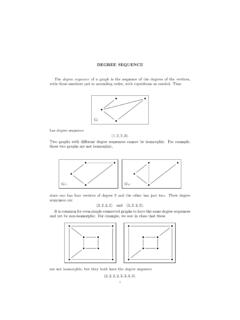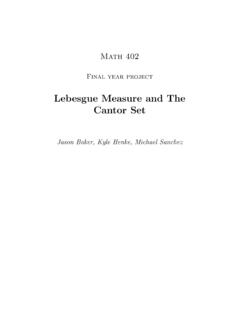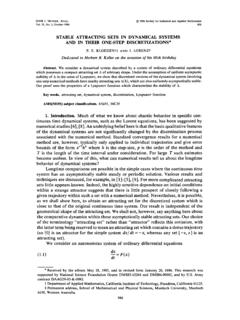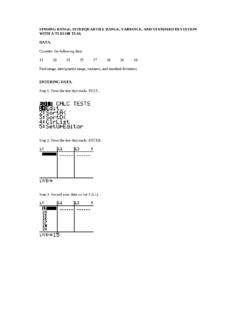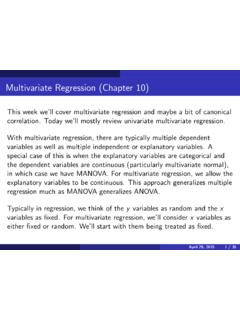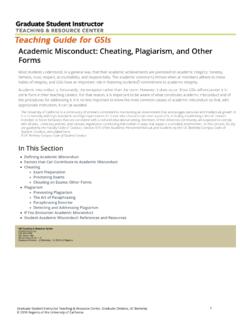Transcription of DETERMINANTS BY ROW AND COLUMN EXPANSION
1 DETERMINANTS BY ROW AND COLUMN EXPANSIONTERRY A. LORING1. EXPANDING ALONG AROW ORCOLUMNThe book does a good job explaining how you can expand on a the can expand on any COLUMN or row. You use a checkerboard pattern tofigure the signs:+ + + ++ + + +and the cross out a row and a columns, several times, to write the big determi-nant as a sum/difference of many (many) smaller , see the ANEXAMPLELet s computedet(A)in several ways, whereA= 0 1 4 323 1 4 406 0 2 323 1 6 60 12 TERRY A. on the second row (twice). 0 1 4 323 1 4 406 0 2 323 1 6 60 = 3 X0 1 4 32X3X1X4X4X0X6 0 2 32X3 1 6 60 + 0X1 4 32X3X1X4X4X06X0 2 323X1 6 60 4 0 1X4 32X3X1X4X4X06 0X2 323 1X6 60 +40 0 1 4X3X2X3X1X4 4XX06 0 2X1X323 1 6X6X0 = 3 1 4 320 2 321 6 60 + 0 4 326 2 323 6 60 4 0 1 326 0 323 1 60 +40 0 1 46 0 23 1 6 = 3 2 1X4 32X0X1X1X61X6 60 32 1 4X3X2X0X1X1X61 6X6XX0 + 6 X0 4 32X3X1X1X6X3 6 60 +2 0X4 32X3X1X1X63X6 60 32 0 4X3X2X3X1X1X63 6X6X0 4 6 X0 1 32X3X0X1X6X3 1 60 32 0 1X3X2X3X0X1X63 1X6X0 +40 6 X0 1 4X3X0X1X3 1 6 2 0 1X4X3X0X13 1X6 = 3(2)
2 1 321 60 32 1 41 6 )+( 6 4 326 60 +2 0 323 60 32 0 43 6 ) 4( 6 1 321 60 32 0 13 1 )+40( 6 1 41 6 2 0 13 1 )= 3(2(28) 32(2))+( 6(48) +2( 96) 32( 12)) 4( 6(28) 32( 3))+40( 6(2) 2( 3))= 3( 8)+( 96) 4( 72)+40( 6)= 24It is not customary to write down the matrices with the crossed out row andcolumn. I just thought one complete example would help Row and COLUMN Operations with operations workjust like row operations for DETERMINANTS . So if all you wantis the determinant, andyou see patterns in the columns, take advantage. The idea is to create lots ofzeros so expanding is not so BY ROW AND COLUMN EXPANSION3In this computation, I do: a type II COLUMN operation (13C1 C1) a type III row operation type III COLUMN operation expand along the second row expand along the second row: 0 1 4 323 1 4 406 0 2 323 1 6 60 =3 0 1 4 321 1 4 402 0 2 321 1 6 60 =3 0 1 4 321 0 0 82 0 2 321 1 6 60 =3 0 1 4 321 0 0 02 0 2 161 1 6 52 = 3 1 4 320 2 161 6 52 = 3( 2 166 52 + 4 322 16 )= 3(8 0))= ops to upper is no rule that says you must write downeach row operation.
3 By not doing so, you shorten your write-up. The trade-off isthat it is harder to follow and harder to find I do a bunch of row operations, keeping a running total (product) of thefactors introduced by each row operation. Notice I start by swapping two rows toget a nonzero number at the top left for a pivot, then divide that by two so it is4 TERRY A. LORING easy to use type I operations to create all zeros below that first pivot. Etc. 0 1 4 323 1 4 406 0 2 323 1 6 60 = 6 0 2 323 1 4 400 1 4 323 1 6 60 = 2 3 0 1 163 1 4 400 1 4 323 1 6 60 = 2 3 0 1 160 1 3 240 1 4 320 1 5 44 = 2 3 0 1 160 1 3 240 0 1 80 0 2 20 = 2 3 0 1 160 1 3 240 0 1 80 0 0 4 = 2 3 1 1 4= OFNEWMEXICO


